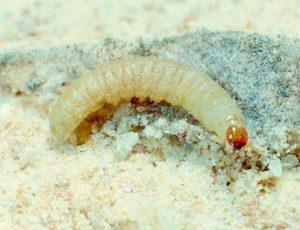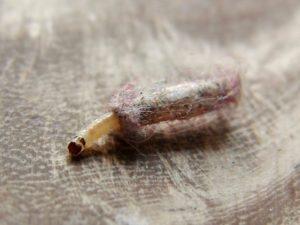Moth: Afraid of cold, frost, or humans
There are many ways to deal with domestic moths, and conditionally they can be divided into 2 categories: the use of household chemicals and folk methods. The latter include the impact on the population of harmful insects by heat and cold. Even our ancestors knew at what temperature the mole dies, and literally froze it or doused it with boiling water.
Content
The nuances of life
Adults of domestic moths have a nondescript appearance. They have a pale grayish coloration, a small body less than 1 cm long, and they are also poor flyers.
Moths do not pose any danger to stored things and products. Their main purpose is to reproduce offspring.
Females find a secluded place in the house, suitable for the further development of the litter, and make a clutch. After a few days, the eggs hatch into larvae., which need a lot of food for further growth and pupation.
They are small translucent worms of pale yellow color with a dark head. Depending on the type of moth, the larvae gnaw on various foods that are tasty to them.
It:
- fur;
- woolen products;
- carpets;
- skin;
- natural fabrics;
- Food;
- furniture upholstery;
- books.
Gaining weight, they pupate, and then turn into butterflies.
At what temperature do moths die?
At an air temperature of +20…+30°C, insects feel comfortable. These are favorable conditions for reproduction and growth of larvae. With a decrease or increase in temperature, the activity of the population decreases, and the metabolism slows down.
Nature has endowed moths with good adaptability to adverse climatic conditions.
With the approach of cold weather, moths clog into cracks, fallen leaves and secluded corners of outbuildings, where they hibernate. When the temperature rises to favorable levels in spring, the insects “wake up” and continue their life cycle. This applies to those individuals that hibernate outside heated rooms.
For moths that live in houses and apartments, sudden changes in temperature are fatal when they take it out of a warm room in the winter to frost, and in the summer in the sun. Moths are afraid of the cold: adults die at -2°C, larvae - at -10°C.
Cold exposure to pests
If it is -10 ° C outside, things affected by the pest must be kept in the cold for a day, if -20 ° C - 8-12 hours are enough. They are taken out to the balcony, shaken out and hung on ropes, straightening as much as possible.
Carpets and fur coats are recommended to be rolled in the snow and slightly knocked out (in the case of carpets, you can beat them harder).
During the time that the clothes are frozen, general cleaning is carried out in the places where the moth and its offspring are found. Shelves and mezzanines are washed with water and soap or vinegar, wiped and dried. At this stage, you can spray surfaces with moth sprays or prepare repellent herbs and spices.
It is known that the moth does not tolerate odors:
- peppermint;
- lavender;
- wormwood;
- citrus;
- geranium;
- tobacco;
- ginger;
- cinnamon;
- garlic.
If the weather is warm outside, you can use the freezer. Small fur and woolen products (hats, scarves, sweaters) are placed there. To increase the efficiency, the freezing process is recommended to be repeated after 3-5 days.
In this article fragrant home protectors from moths are described in detail.
Thermal impact
Having found out whether the moth is afraid of frost and how this can be used in the fight against it, we move on to the next question - thermal effects. Moths and their larvae do not tolerate high temperatures and direct sunlight.
- In summer, fur and woolen products are taken outside and hung in the sun. The high temperature formed in well-warmed clothes is detrimental to eggs, larvae and adult insects. And moths can not even tolerate sunlight.
- If a thing can burn out, it is turned inside out before being placed in the sun.
- Items of clothing that can be washed at temperatures above 45°C should be sent to the washing machine. This will ensure the death of the butterfly at all stages of development.
- Carpets and upholstered furniture are blown with hot air using a technical hair dryer.
- If there is a dryer or sauna, clothes are left in them for several hours. Neither insect eggs, nor larvae, nor adults will survive.
Combining the effects of heat and cold, you can achieve a 100% result. For example, wash things in hot water and take out to dry in the cold. True, this cannot be done with woolen and fur products. And with cotton, linen and synthetic - it's easy.
If the moth is food
In the case of food contamination by moths, the use of freezing is difficult. If containers with cereals or other food supplies are taken out into the cold, insects protected by a loose layer will not die, but will fall into suspended animation.
On the other hand, it is also not possible to clean cereals or flour from waste products of moths. Therefore, to destroy insects, boiling water is poured into food jars, and then the contents are disposed of.
The minimum is 50 degrees. But the more, the more efficient and faster the process will go. It is necessary to look at things and not harm them, because not all fabrics tolerate high temperatures well.
Yes, at least 30 minutes at 60 degrees. So they will not deteriorate, and the pests will be destroyed.
Prevention of the appearance of moths
Preventive measures include:
- regular cleaning and ventilation of premises;
- sending only clean things for storage;
- periodic inspection of the contents in cabinets, chests of drawers and on the mezzanine and food stocks;
- storage of bulk products in closed containers;
- the use of repellents.


Watch this video on YouTube
The appearance of a moth is easier to prevent than to deal with its consequences. Well, if a harmful insect is found, you must immediately take measures to exterminate it. Knowing at what temperature moth larvae and adults die, it is possible to influence them with heat and cold, and only in extreme cases use chemical agents.
Previous



